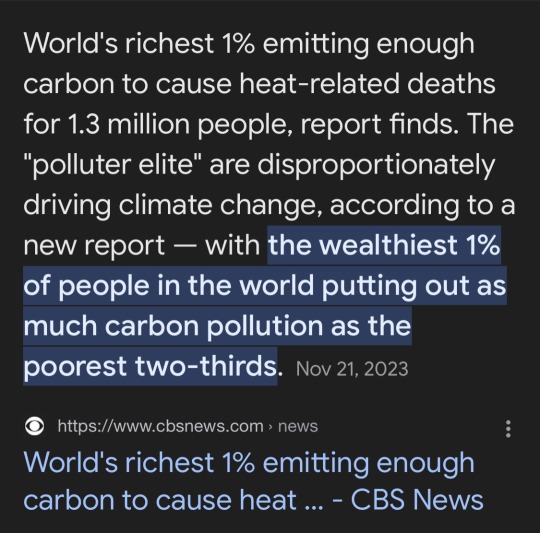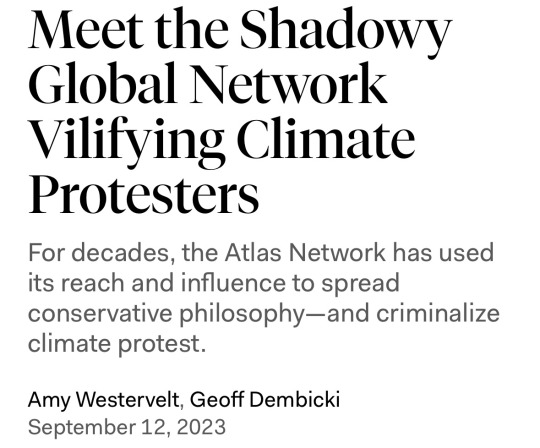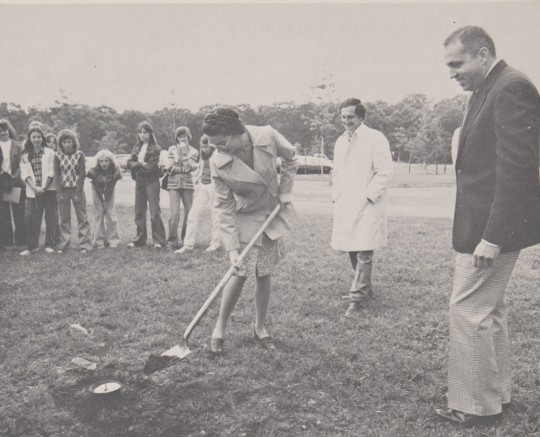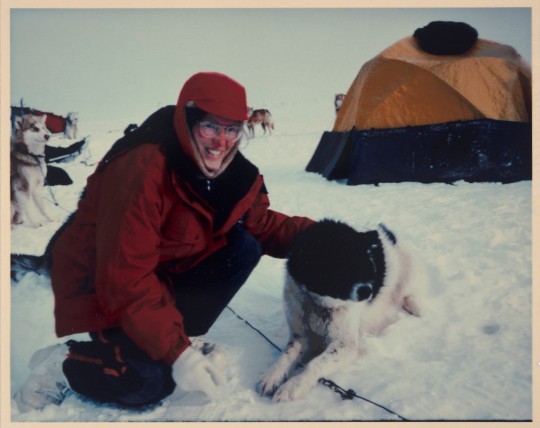#climate science
Text

DR ADAM LEVY ClimateAdam
ROSEMARY MOSCO
#comic#climate change#climate science#climate action#climate crisis#doom scroll break#radical optimism#hope is a radical act
26K notes
·
View notes
Text

Source
More of this
#government#environment#environmentalism#environmetalists#climate science#climate activism#news#current events#Europe#the left#progressive
19K notes
·
View notes
Text

Confirmed: Summer 2023 Hottest in NASA’s Record
All three months of summer 2023 broke records. July 2023 was the hottest month ever recorded, and the hottest July. June 2023 was the hottest June, and August 2023 was the hottest August.
NASA’s temperature record, GISTEMP, starts in 1880, when consistent, modern recordkeeping became possible. Our record uses millions of measurements of surface temperature from weather stations, ships and ocean buoys, and Antarctic research stations. Other agencies and organizations who keep similar global temperature records find the same pattern of long-term warming.
Global temperatures are rising from increased emissions of greenhouse gasses, like carbon dioxide and methane. Over the last 200 years, humans have raised atmospheric CO2 by nearly 50%, primarily through the burning of fossil fuels.
Drivers of climate change, both natural and human-caused, leave distinct fingerprints. Through observations and modeling, NASA researchers confirm that the current warming is the result of human activities, particularly increased greenhouse gas emissions.
6K notes
·
View notes
Text
For the first time, global warming has exceeded 1.5C across an entire year, according to the EU's climate service.
World leaders promised in 2015 to try to limit the long-term temperature rise to 1.5C, which is seen as crucial to help avoid the most damaging impacts.
This first year-long breach doesn't break that landmark Paris agreement, but it does bring the world closer to doing so in the long-term.
Urgent action to cut carbon emissions can still slow warming, scientists say.
Continue Reading.
1K notes
·
View notes
Text

Wolves Keep Brain Worm–Spreading Deer Away From Moose Populations in Minnesota
Wildlife managers now face the challenge of creating conservation plans for all three species while maintaining balance between predator and prey animals
In Minnesota, moose used to roam the boreal forests by the thousands. The population had 8,800 individuals in 2006, and since then, numbers in the northeastern part of the state alone have fallen by 64 percent, reports Liz Scheltens for Vox.
Warmer, shorter winters, tick infestations, liver issues, wolves, and parasites all contribute to declines in remnant Minnesota moose populations, reports Dennis Anderson for the Star Tribune.
However, the biggest threat may be migrating white-tailed deer. As deer entered moose habitats, they brought brainworm, a fatal parasite to moose. While harmless to white-tailed deer, the parasite (Parelaphostrongylus tenuis) causes disorientation, extreme weakness, and the inability to stand in moose.
It may be a critical factor as to why Minnesota's northern moose populations have declined significantly...
Read more:
https://www.smithsonianmag.com/smart-news/plummeting-minnesota-moose-populations-may-recover-with-help-from-wolves-180979484
#moose#ecology#climate#climate science#parasites#ungulate#mammal#animals#nature#north america#wildlife science#science
242 notes
·
View notes
Text
So having a fossil fuel executive as the president of the UN Climate Summit is going about as well as expected


Fossil fuel companies and the politicians they employ are murderers. And they should be treated as such.

Abolish billionaires. Ban private jets & mega yachts. Invest in renewable energy and stop listening to politicians and corporations over scientists.
#cop28#climate change#capitalism#eat the rich#climate crisis#wealth inequality#late stage capitalism#us politics#climate emergency#climate activism#joe biden#climate science#fossil fuels#climate justice#climate news#climate solutions#tax the rich#abolish billionaires
292 notes
·
View notes
Text

not much left to say at this point. february 2024 had an anomaly of almost 2 degrees. the climate has hit some sort of major tipping point. exponential growth is a real thing and everyone is about to get a crash course on it. again. (see: covid)
192 notes
·
View notes
Text
Connecting on Climate
Often, I think we need to shift the climate and biodiversity crises discussions from facts to stories.
Why choose native trees and plants?
Well, do you remember how bugs splatted on your windshield decades ago compared to now?
Do you remember the fireflies of childhood?
After we notice, after we link these ideas to our personal stories, then it's time to cultivate questions.
Who else misses these insects?
What about plants with absent pollinators.
What about bats and birds missing their food?
Our kids missing constellations of fireflies?
We link to personal stories.
We foster the follow-up questions.
Then, we reject abstraction and hopelessness. We reject all or nothing thinking and tie our concerns to concrete things we CAN do.
We teach the immense power of doing something even when we can't do everything.
There is so much we do not control.
Yet, we do control some things.
We have agency.
Perhaps you can plant a white oak and learn/notice who benefits.
Perhaps you can reject lawn and cultivate native plants.
Perhaps you can volunteer or donate or reject damaging products. People care when the issue at hand feels like a part of their own story. People continue to care when they believe they have the power to participate in shaping the story's future.
We need to get creative and bring the facts home to people's stories, to their sense of self, but the good news is the truth is a wind at our backs.
Our environment IS a part of everyone's personal story and our individual actions can/do shape the future of our planet.
1K notes
·
View notes
Text
As historian Paul Edwards argues, climate science and meteorology were the first fields that collected and processed global data in near real time. To make even a banal statement like ‘The world has warmed by 1°C since 1850’, scientists need to compile data from a vast global network of ground observation sites, weather balloons, research vessels, and satellites, then feed that data into enormous physical and mathematical models to form a coherent world picture. Edwards calls climate science a ‘vast machine’ in that it is ‘a sociotechnical system that collects data, models physical processes, tests theories, and ultimately generates a widely shared understanding of climate and climate change.’
Troy Vettese, Drew Pendergrass, Half-Earth Socialism: A Plan to Save the Future from Extinction, Climate Change and Pandemics
225 notes
·
View notes
Text

Cartoon by Drew Sheneman
92 notes
·
View notes
Text
Climate Change
from The Guardian

#climate change#climate science#climate crisis#💙voteblue#vote democrat#biden/harris 2024#execute traitor trump!
70 notes
·
View notes
Text


Source

Source
#climate science#climate justice#climate action#climate emergency#climate crisis#fossil fuels#ban fossil fuels#news#current events#capitalism
567 notes
·
View notes
Text

LaRue Burbank, mathematician and computer, is just one of the many women who were instrumental to NASA missions.
4 Little Known Women Who Made Huge Contributions to NASA
Women have always played a significant role at NASA and its predecessor NACA, although for much of the agency’s history, they received neither the praise nor recognition that their contributions deserved. To celebrate Women’s History Month – and properly highlight some of the little-known women-led accomplishments of NASA’s early history – our archivists gathered the stories of four women whose work was critical to NASA’s success and paved the way for future generations.
LaRue Burbank: One of the Women Who Helped Land a Man on the Moon
LaRue Burbank was a trailblazing mathematician at NASA. Hired in 1954 at Langley Memorial Aeronautical Laboratory (now NASA’s Langley Research Center), she, like many other young women at NACA, the predecessor to NASA, had a bachelor's degree in mathematics. But unlike most, she also had a physics degree. For the next four years, she worked as a "human computer," conducting complex data analyses for engineers using calculators, slide rules, and other instruments. After NASA's founding, she continued this vital work for Project Mercury.
In 1962, she transferred to the newly established Manned Spacecraft Center (now NASA’s Johnson Space Center) in Houston, becoming one of the few female professionals and managers there. Her expertise in electronics engineering led her to develop critical display systems used by flight controllers in Mission Control to monitor spacecraft during missions. Her work on the Apollo missions was vital to achieving President Kennedy's goal of landing a man on the Moon.
Eilene Galloway: How NASA became… NASA

Eilene Galloway wasn't a NASA employee, but she played a huge role in its very creation. In 1957, after the Soviet Union launched Sputnik, Senator Richard Russell Jr. called on Galloway, an expert on the Atomic Energy Act, to write a report on the U.S. response to the space race. Initially, legislators aimed to essentially re-write the Atomic Energy Act to handle the U.S. space goals. However, Galloway argued that the existing military framework wouldn't suffice – a new agency was needed to oversee both military and civilian aspects of space exploration. This included not just defense, but also meteorology, communications, and international cooperation.
Her work on the National Aeronautics and Space Act ensured NASA had the power to accomplish all these goals, without limitations from the Department of Defense or restrictions on international agreements. Galloway is even to thank for the name "National Aeronautics and Space Administration", as initially NASA was to be called “National Aeronautics and Space Agency” which was deemed to not carry enough weight and status for the wide-ranging role that NASA was to fill.
Barbara Scott: The “Star Trek Nerd” Who Led Our Understanding of the Stars

A self-described "Star Trek nerd," Barbara Scott's passion for space wasn't steered toward engineering by her guidance counselor. But that didn't stop her! Fueled by her love of math and computer science, she landed at Goddard Spaceflight Center in 1977. One of the first women working on flight software, Barbara's coding skills became instrumental on missions like the International Ultraviolet Explorer (IUE) and the Thermal Canister Experiment on the Space Shuttle's STS-3. For the final decade of her impressive career, Scott managed the flight software for the iconic Hubble Space Telescope, a testament to her dedication to space exploration.
Dr. Claire Parkinson: An Early Pioneer in Climate Science Whose Work is Still Saving Lives

Dr. Claire Parkinson's love of math blossomed into a passion for climate science. Inspired by the Moon landing, and the fight for civil rights, she pursued a graduate degree in climatology. In 1978, her talents landed her at Goddard, where she continued her research on sea ice modeling. But Parkinson's impact goes beyond theory. She began analyzing satellite data, leading to a groundbreaking discovery: a decline in Arctic sea ice coverage between 1973 and 1987. This critical finding caught the attention of Senator Al Gore, highlighting the urgency of climate change.
Parkinson's leadership extended beyond research. As Project Scientist for the Aqua satellite, she championed making its data freely available. This real-time information has benefitted countless projects, from wildfire management to weather forecasting, even aiding in monitoring the COVID-19 pandemic. Parkinson's dedication to understanding sea ice patterns and the impact of climate change continues to be a valuable resource for our planet.
Make sure to follow us on Tumblr for your regular dose of space!
#NASA#space#tech#technology#womens history month#women in STEM#math#climate science#computer science
2K notes
·
View notes
Text
Hey, so what if we had a more sustainable transparent material stronger than carbon nanofibers?

One of the most interesting articles I'll read this week, I suspect. Lots of details about the process, as well as more recent incremental improvements to producing this in a greener and more scalable way.
94 notes
·
View notes
Text

📷 @flictedimages
#animals#nature#climate change#science#climate science#capitalism#politics#polar bear#arctic#environment#conservation
786 notes
·
View notes
Text

this is uh. this is the daily chart of the world ocean temperatures from climatereanalyzer.org.
i realize that human beings sometimes struggle to grasp the concept of exponential growth but i think it’s really important to familiarize yourself with feedback loops and how they function because it really seems like we’ve crossed a major climate milestone. the oceans are not supposed to be warming like this right now.
mind you, this is breaking a record and temperatures only are expected to increase from here. look at the bell curve for the previous years. look at the black line showing 2024. see how it’s pointing straight up? this summer is going to be incredibly dangerous. that’s an understatement. and plus the effect on marine life, ocean currents, etc are very likely catastrophic.
if you encounter people who are climate skeptics in your life, you have a duty to loudly drown them out with facts. it is a fact that the oceans are warmer than they’ve ever been. it is a fact that we need to make drastic, overwhelming shifts to our way of living and how we view the world if we want to retain a world to live in.
59 notes
·
View notes